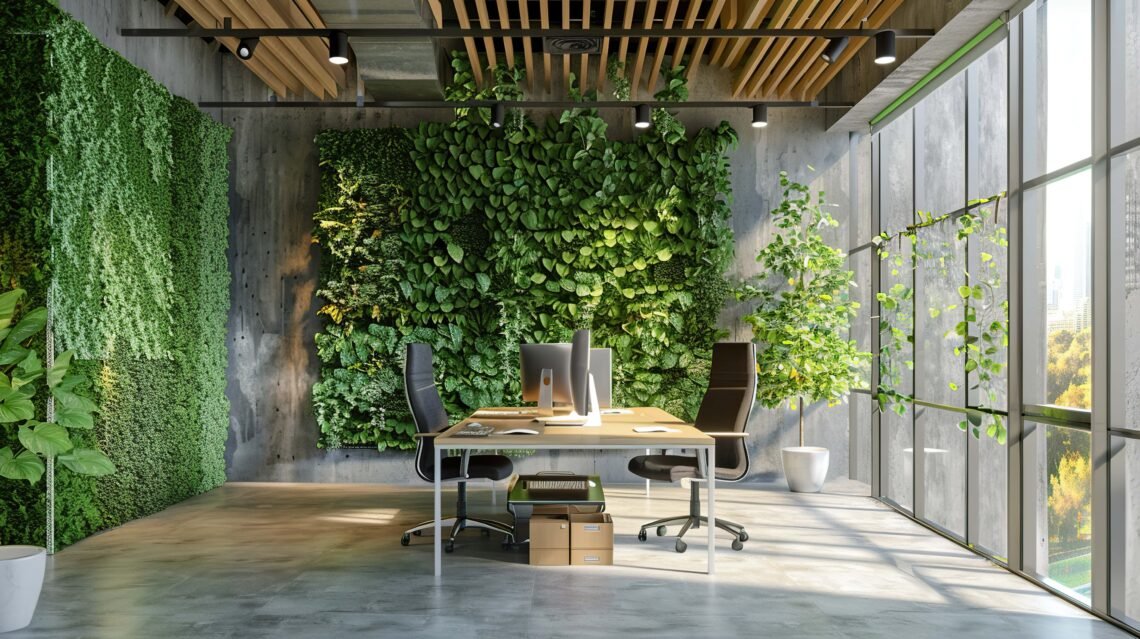Imagine walking into a room that instantly feels like home—not just because it’s beautiful, but because it resonates with you on a deeper level. That’s the magic of holistic interior design. It’s not about chasing trends or piling on expensive furniture; it’s about creating spaces that nourish your physical, mental, and emotional well-being. In this article, we’ll dive into what holistic interior design truly means, why it’s transforming homes worldwide, and how you can bring this soulful approach into your own space. Drawing from real-life examples and practical tips, we’ll explore how to craft environments that feel as good as they look.
What Is Holistic Interior Design?
Holistic interior design is a philosophy that goes beyond aesthetics to consider the entire human experience within a space. It blends functionality, beauty, and well-being, focusing on how environments impact your physical health, mental clarity, and emotional balance. Think of it as designing with intention—every choice, from lighting to materials, is made to create harmony and support the people who live there.
Why It’s More Than Just Decorating
Unlike traditional interior design, which often prioritizes visual appeal, holistic design digs deeper. It asks: How does this space make you feel? Does it energize you or calm you? By considering energy flow, natural elements, and personal needs, it creates spaces that nurture rather than just impress. For example, a friend of mine once redesigned her living room with soft lighting and natural wood to combat stress, and the difference was night and day—she felt calmer the moment she walked in.
The Roots of Holistic Design
Holistic design draws inspiration from ancient practices like Feng Shui and biophilic design, which emphasize harmony with nature and energy flow. It’s about creating a dialogue between the space and its inhabitants. I remember visiting a holistic designer’s project that incorporated Feng Shui principles—the furniture placement felt so intuitive, it was like the room was hugging you.
Key Principles of Holistic Interior Design
Holistic interior design is built on a few core principles that guide every decision. These principles ensure that spaces are not only beautiful but also supportive of your overall well-being. Let’s break them down.
Prioritizing Well-Being Over Trends
Trends come and go, but a holistic approach focuses on timeless elements that promote health and happiness. This means choosing non-toxic materials, optimizing natural light, and creating clutter-free zones. A well-lit room with clean air can reduce stress and boost mood, making it a cornerstone of holistic design.
Connecting With Nature
Biophilic design, a key component, emphasizes natural elements like wood, stone, and plants to create a calming effect. I once helped a client add a small indoor garden to their home office, and they swore it made their workdays feel less draining. Natural elements ground us, connecting us to the outdoors even when we’re inside.
Personalization for Emotional Resonance
Every person is unique, and holistic design reflects that. It incorporates personal touches—like artwork or colors that evoke joy—to make spaces feel deeply personal. For instance, a couple I know designed their bedroom with mementos from their travels, turning it into a sanctuary of memories that sparked joy every night.
Energy Flow and Balance
Inspired by Feng Shui, holistic design considers how energy moves through a space. Furniture placement, open pathways, and balanced layouts create a sense of flow. I’ve seen rooms transformed just by moving a sofa to allow better movement—suddenly, the space felt alive and inviting.
Benefits of Holistic Interior Design
Adopting a holistic approach can transform not just your home but your life. Here’s why it’s worth considering for your next design project.
Improved Physical Health
Holistic design prioritizes clean air, natural light, and non-toxic materials, which can reduce allergies and improve overall health. Studies show that good indoor air quality can lower respiratory issues by up to 20%. A client of mine switched to low-VOC paints and noticed her kids’ allergies improved significantly.
Enhanced Mental Clarity
Clutter-free spaces and calming colors can reduce stress and improve focus. A study from Princeton found that clutter can overwhelm the brain, making it harder to concentrate. By designing with simplicity in mind, holistic interiors create mental breathing room.
Emotional Connection and Comfort
Spaces that reflect your personality feel like a warm embrace. Whether it’s a cozy reading nook or a vibrant kitchen, holistic design ensures your home supports your emotional needs. I once designed a meditation corner for a friend, and she said it became her go-to spot for finding peace.
Comparing Holistic vs. Traditional Interior Design
| Aspect | Holistic Design | Traditional Design |
|---|---|---|
| Focus | Well-being, energy flow, personalization | Aesthetics, trends, functionality |
| Materials | Natural, non-toxic, sustainable | Often synthetic, trend-driven |
| Energy Consideration | Emphasizes Feng Shui and energy balance | Rarely considers energy flow |
| Outcome | Spaces that nurture body, mind, and soul | Visually appealing but may lack deeper impact |
Holistic design stands out for its focus on the human experience, while traditional design often prioritizes looks over long-term well-being. If you’re torn between the two, holistic design offers a more sustainable, meaningful approach.
Pros and Cons of Holistic Design
Pros:
- Enhances physical and mental health
- Creates personalized, emotionally resonant spaces
- Uses sustainable, eco-friendly materials
- Promotes long-term comfort and balance
Cons:
- Can be more time-intensive to plan
- May require higher initial costs for natural materials
- Requires understanding of energy flow principles
How to Implement Holistic Design in Your Home
Ready to bring holistic design into your space? Here’s a step-by-step guide to get started, whether you’re redesigning a single room or your entire home.
Step 1: Assess Your Needs
Start by asking what you need from your space. Do you want a calming bedroom or an energizing workspace? I once sat down with a client who realized her home office felt chaotic because it doubled as a storage room—identifying this was the first step to fixing it.
Step 2: Choose Natural Materials
Opt for wood, stone, or bamboo over plastic or synthetic materials. These choices not only look beautiful but also create a healthier environment. For example, swapping out a plastic coffee table for a reclaimed wood one can add warmth and reduce indoor toxins.
Step 3: Optimize Lighting
Natural light is a game-changer. Use sheer curtains to let sunlight in and add warm, dimmable lights for evenings. A designer I worked with transformed a dark living room by adding skylights, and the space felt like a new home.
Step 4: Incorporate Plants
Plants like peace lilies or snake plants purify the air and add a touch of nature. I added a few to my own apartment, and they made the space feel fresher and more alive. Check out The Sill for easy-to-care-for indoor plants.
Step 5: Declutter and Simplify
Less is more in holistic design. Keep only what serves a purpose or brings joy. When I helped a friend declutter her kitchen, we donated half her unused gadgets, and she said cooking became a joy again.
Best Tools for Holistic Interior Design
To bring your holistic vision to life, you’ll need the right tools. Here are some of the best options for planning and executing your design.
| Tool | Purpose | Where to Get It |
|---|---|---|
| RoomSketcher | Create 2D/3D floor plans with holistic layouts | RoomSketcher |
| Havenly | Online design consultations with a holistic focus | Havenly |
| Feng Shui Guide Apps | Plan furniture placement for energy flow | App Store or Google Play |
| Color Wheel Tools | Choose calming, personalized color palettes | Canva Color Wheel |
These tools make it easy to visualize and implement holistic principles, whether you’re a DIYer or working with a professional.
Where to Find Holistic Interior Design Inspiration
Looking for ideas to spark your holistic design journey? Here are some great places to start:
- Pinterest: Search for “biophilic design” or “holistic home decor” for endless inspiration. I found a gorgeous mood board there that inspired my own bedroom redesign.
- Instagram: Follow designers like @maisonblancdesign for stunning holistic projects. Their “House in the Trees” project is a perfect example of nature-inspired design.
- Design Blogs: Sites like Apartment Therapy offer practical tips and real-life examples of holistic spaces.
- Local Showrooms: Visit sustainable furniture stores in your area for hands-on inspiration. I once stumbled upon a reclaimed wood dining table that became the centerpiece of a client’s holistic dining room.
People Also Ask (PAA)
What is holistic interior design?
Holistic interior design is an approach that considers the physical, mental, and emotional impact of a space. It uses natural materials, balanced layouts, and personalized elements to create environments that promote well-being. Unlike traditional design, it prioritizes harmony and health over aesthetics alone.
How does holistic design differ from traditional interior design?
Holistic design focuses on the occupant’s well-being, incorporating energy flow, natural elements, and personalization. Traditional design often emphasizes visual trends and functionality without considering deeper emotional or health impacts. Holistic spaces feel more nurturing and intentional.
How can I make my home more holistic?
Start by decluttering, adding plants, and using natural materials like wood or stone. Optimize lighting with natural sunlight and choose colors that resonate with you. Consider Feng Shui principles for furniture placement to enhance energy flow.
What are the benefits of holistic interior design?
Holistic design improves physical health through better air quality, enhances mental clarity with clutter-free spaces, and fosters emotional connection through personalization. It creates homes that feel balanced, calming, and deeply personal, supporting overall well-being.
FAQ: Holistic Interior Design
Q: What makes a space holistic?
A: A holistic space promotes well-being through natural materials, balanced energy flow, and personalization. It considers how the environment affects your body, mind, and emotions, creating a nurturing and harmonious atmosphere.
Q: Can I apply holistic design on a budget?
A: Absolutely! Start with small changes like decluttering, adding affordable plants, or rearranging furniture for better flow. Thrift stores often have natural wood pieces, and DIY projects can add personal touches without breaking the bank.
Q: Do I need a professional for holistic design?
A: Not necessarily. While professionals bring expertise, you can apply holistic principles yourself using online tools, research, and intuition. However, a designer with holistic training can help refine complex projects.
Q: How does Feng Shui fit into holistic design?
A: Feng Shui is a key influence, guiding furniture placement and layout to optimize energy flow. It ensures spaces feel balanced and harmonious, aligning with holistic design’s focus on well-being.
Q: Are there specific colors for holistic design?
A: Holistic design favors calming, earthy tones like greens, blues, and neutrals, but the best colors are those that resonate with you. Use a color wheel tool to find shades that feel personal and soothing.
Bringing It All Together
Holistic interior design is about creating spaces that feel like an extension of you—beautiful, functional, and deeply nurturing. By prioritizing well-being, natural elements, and personal touches, you can transform your home into a sanctuary that supports your body, mind, and soul. Whether you’re starting with a single room or reimagining your entire space, the principles of holistic design offer a roadmap to a more balanced, joyful life. So, grab a plant, rearrange that sofa, and let your home tell your story. What’s the first holistic change you’ll make today?





